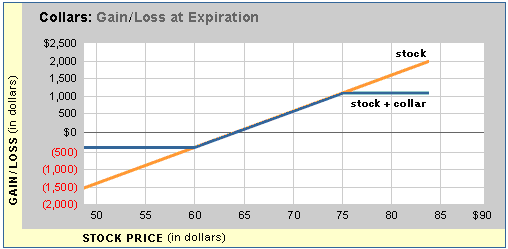An investor is long 100 shares of XYZ at $64.00, and wants to protect his downside risk using a protective collar. The important things are the percentage loss the customer is willing to assume, and the point that the investor is willing to lose the stock through assignment of the short call position. Let's assume that the investor is only willing to lose 5 to 10 percent on the downside, and will only sell his stock on a 10 to 20 percent move upwards. Let’s assume that the XYZ 60 Puts are trading at .95, and the XYZ 75 Calls are trading at .95. The net effect of establishing a collar (long stock +long put + short call) using these two strikes is a net debit/credit of $0. The investor is protected after a 6.25% loss, and may participate in an upside move of up to 17.2%. The investor assumes some risk of loss in exchange for retaining some of the upside potential of his XYZ position. With a net debit/credit of $0, the breakeven price for this strategy remains $64.

 EXAMPLE - Collar on long equity position
EXAMPLE - Collar on long equity position